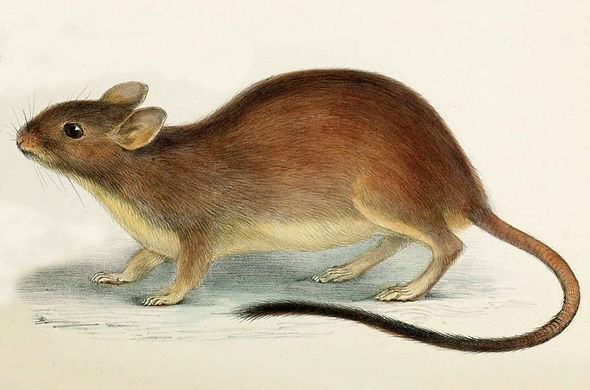Creature
Fast Facts
Introducing you to extinct species.

THE WHITE-FOOTED
RABBIT-RAT
1. The white-footed rabbit-rat, Conilurus albipes, was “kitten sized”making it one of Australia’s largest native rodents. The extinct Capricorn rabbit-rat was slightly larger. 2. Its range was from Adelaide to Sydney where in 1788 it was seen as a pest, raiding settler’s food. Its range soon dwindled to an area to the south-east of Australia. 3. The white-footed rabbit-rat was called 'gnar-ruck' by the Aborigines which translates as 'rabbit-biscuit'. 4. It had a head/body length of 10.2 inches and a tail length of 9.4 inches. 5. Its tail was bushy with dark brown on the top and white underneath. 6. The dorsal side was gray-brown and the underside and feet of this rabbit-rat were white, though it seemed to vary slightly by region. 7. In 1846, John Cotton noted it was common in Victoria, but it disappeared by 1860. 8. The white-footed rabbit-rat preferred open forest woodlands and grasslands. 9. One female was recorded as having filled a hollow long to a depth of 23 inches to create a nest. 10. It was noted to be nocturnal, but several reports show they were active during the day. 11. The extinction date is unknown. The last confirmed specimen was collected in 1845, but four more were collected and lost in 1856-57. Some sightings were reported in 1861 and 1862. The last unconfirmed report was in the 1930’s.
Extinction
Cometh
Facing the light at the end of the tunnel
EXTINCTION DATE
1857
The white-footed rabbit-rat was a common rodent found from Adelaide to Sydney. In fact there are reports that it was a problem in getting into stores in 1788. No one knows exactly what caused the steep decline in their population. There were many factors such as the ending of Aboriginal fire-stick farming, which was controlled burning that kept forests in check . Some scientists believe diseases spread by invasive rodents could have been the catalyst in the population decline. The white-footed rabbit-rat also had to compete against invasive species like the "gray blanket" aka the escalated rabbit population. The introduction of the red fox in the 1870's for recreational hunting and feral cats also took their toll on this kitten-sized rodent. The last white-footed rabbit-rat specimen was collected in 1845. John Cotton said the white-foot rabbit-rats were common in Victoria in 1846. The population took a steep decline and was last reported in Victoria between 1860-1862. There were even reports of sightings as recently as the 1930’s, but those reports were never confirmed. Could the white-footed rabbit-rat mouse live in Australia today? Although Jurassic Park is fiction, scientists are working on several de-extinction projects. In fact, in 2003 scientists did bring back the extinct Pyrenean ibex, a type of wild goat, for 7 minutes before it died, showing de-extinction is possible. The white-footed rabbit-rat could be a good candidate. Scientists would use the DNA found in museum specimens. Australia has made many strides in restoring natural habitats, eliminating invasive species, and helping struggling species recover since the extinction of the white-footed rabbit-rat in 1857. Scientists have been working to keep the brush-tailed rabbit-rat population intact. They could use their knowledge from those conservation efforts to help protect the white-footed rabbit-rat. If the white-footed rabbit-rat was brought to life, could it ever be reintroduced to its native homeland in Australia?
COMING
SOON
The white-footed rabbit rat's Lazarus tale has yet to be written, but what adventures will await it when it returns to Australia? Stay tuned to find out.
More to Explore
All answers lead to more questions


Artwork by John Gould showing a family of white-footed rabbit rats
Image from Wikipedia
A museum specimen of the white-foot rabbit rat
Image from Museums Victoria Collections

Artwork of Conilurus albipes
Image from Fur Affinity

Artwork for Rodent Stamp #5700
Image from Hip Stamp

An 1850 painting of the brush-tailed Rabbit rat by John Edward Gray
Image from Wikipedia

A photo of the endangered brush-tailed rabbit rat
Image from Northern Territory Government

Researcher Hugh Davies poses with a brush-tailed rabbit rat as part of a cat impact study on the species
Image from Threatened Species Recovery Hub



